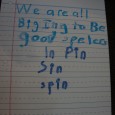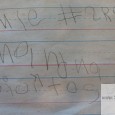If you’re a regular reader, you know how I feel about school uniforms and you know that we chose to opt out of the “mandatory” uniform requirement at Honeybun’s school (check out “A Uniformed Education” and “The First Day” for a refresher). We abide by the dress code which includes things like no jeans, gym shorts, leggings or logos. I’m all for a dress code which ensures children are dressed appropriately for school and learning but I do not believe in every child looking the same. We’ve had no issues since the first weeks of school when Honeybun would come home telling me “the gym/music/Spanish teacher told me I wasn’t in the right uniform.” And while Honeybun seems to be the only child in the entire SCHOOL that does not wear the uniform, it does not bother her (or hubby and me).
What has begun to bother me, though, is the seeming lack of dress code for the teachers and other staff. Each afternoon as the children trickle out in their monotonous, matching clothes, this is what I see from the staff:
Some of the teachers do dress how I feel is appropriate in nice but relaxed clothes and comfortable flats (which is how I always dressed myself as a pre-school teacher). What bothers me, though, is the overabundance of jeans (not permitted for students) and open toed shoes, mostly flip-flops (absolutely not acceptable for students). The school states on their website that “Research Suggests that school uniforms identify student population from strangers on school grounds” and as I pointed out in “A Uniformed Education”, a 5 year-old not in uniform will probably not raise questions about whether or not she belongs at the school. However, there is often no way to tell the staff from the parents (or strangers) aside from the ID badges which the staff have but are not always visible.
In addition to the jean and flip-flop epidemic I’ve also seen some very disturbing clothing choices by the staff. I saw one teacher/assistant one day wearing a very short sun dress with a SHEER sweater over and her bra blatantly hanging out of the back of her dress. I guess I’m irritated about it because it feels like a “do what I say, not as I do” sort of thing. There are rules and high expectations for the students but the staff is not held to the same standards. I strongly believe in modeling appropriate behaviors, not just expecting children to adhere to seemingly random expectations.








I agree with everything you said. We have the same issues at all my children’s schools. Emily, my eldest daughter is on the autism spectrum. We spent years trying to get her to dress herself for school and finally we are there.Finally at age ten, she wakes in the morning, brushes her teeth, hair and gets dressed on her own. She looks forward to no school uniforms for a fee each week on Friday’s called “Greens For Jeans”, costs two dollars. So we rush out the door with five kids, each with several morning concerns and make our way to three schools for drop-off every morning. However, Emily sometimes wears shorts that are either too short, wrong color (not jeans) or a shirt that has small straps like tank tops and the school will quarantine her like a criminal (remove her from a learning environment like math class) until we drive back to school to pick her up and change her clothes. I find that offensive. Children are there to learn and that should be the primary focus. If her clothing of the day is not interrupting or disturbing to anyone leave it alone. Why the strict enforcement if it is not bothering anyone? A better strategy would be to send a note home and not remove a child from a learning environment because of a subjective rule. I find the staff at the school wearing the same types of clothing especially the younger staff. I believe the rules should be applied to all who attend and not just those “mischievous kids” as one staff member generalized the entire student body.
Joe,
I am so sad to hear about the struggles you have with your daughter. I agree that if a child’s dress is not disruptive then children (with the guidance of their parents) should be allowed to make their own wardrobe choices. Schools are trying to make all children seem equal and the same instead of teaching children to make appropriate choices, teaching them to be accepting of others and teaching them that bullying and teasing are wrong. They’re taking the lazy way out and in the end I think it is actually making appearance seem more important rather than downplaying it like it intended. When we tell children they can’t have something, they place more value on it so by taking away the opportunity to see lots of different types of people and individualism they will notice and have more extreme reactions to differences when they do encounter them. I also think it’s going to create a generation of children who can’t make independent choices and believe fitting in and being like everyone else is more important than thinking for yourself and making choices based on what is morally right.